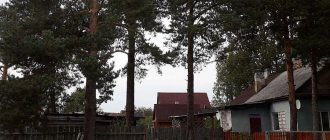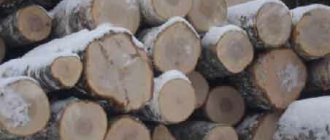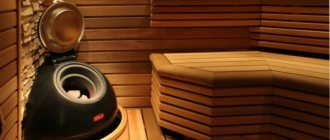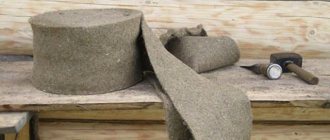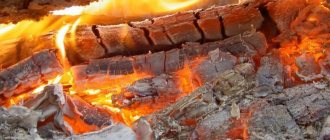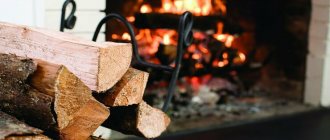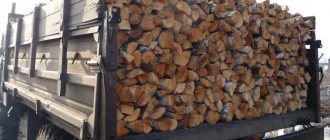To answer this question objectively, one should consider representatives of coniferous species in more detail and regarding their “usefulness” for construction and comfort in general. The table below is not intended to compare both trees, but clearly demonstrates the real qualities of the varieties of lumber for construction. After studying this information, you can draw a conclusion about the advisability of purchasing one or another type.
Table of real qualities of spruce and pine
If the information is not enough, you can always turn to competent sources for clarification. Below is a detailed description of each item in the table. So:
| Useful properties of the rock for private construction | Spruce | Pine |
| Color | White | From bright yellow to brick |
| Shade stability | High | Changes to a more intense shade |
| Fiber structure | Uniform | Pronounced |
| Natural humidity | 12% | 12% |
| Resin content | Low | High |
| Knotiness | A large number of small | A small number of large |
| Natural protection against rotting | Average | High and even exceptional, depending on the variety |
| Sineva | Doesn't turn blue | This effect wears off over time |
| Mechanical restoration | Difficult due to a large number of knots | Any |
| Scope of use | Baths, gazebos, furniture | Residential buildings, log houses, frame |
| Price | From 2500 rub/m³ | Up to 4000 rub/m³ |
General qualities include the longevity of the material and the finished log house. Some of them can stand for at least 300 years. It is worth paying attention to the diameters of the trunks; the larger, the warmer - spruce cannot boast of this, but pine, on the contrary.
So, what kind of wood is best to build a house from? Spruce, pine or pay attention to other species? The answers from the table are given below.
Fiber color and structure
This is what attracts customers visually and leaves a mark in their memory. From this point of view, a house made of pine is more attractive than a log house made of spruce, which has a single shade that does not change over time. The variety of colors from sunny to ocher is appreciated by true aesthetes.
However, buyers are put off by the blue. They consider this an indicator of rot. People! This is wrong! This only indicates the freshness of the cut and over time the pine will become beautiful, and even change shades.
And a house made of spruce, like all wood, will become dark from humidity and nothing more. Annual rings delight the eye with their unusual pattern - this fact applies to pine. Spruce cannot boast of this - its structure is uniform and invisible due to its color.
Benefits of spruce
- Spruce differs from pine in its velvety golden hue, which it retains for as long as possible.
- Spruce is not prone to cracking and has lower resin content than pine.
- The material belongs to the category of hardwood, has many knots and is generally more difficult to process than pine.
- After drying, the spruce loses the lion's share of its mass, becoming lighter and easier to process.
- The elasticity of spruce allows it to be made into bent elements.
Resinousness and knotiness
Why is spruce recommended for the construction of baths? This is all due to the small amount of resin, which is no different from pine. When heated, the resin actually flows along the walls, creating discomfort for visitors.
In addition to sloppiness, this effect has another unpleasant and, frankly speaking, destructive feature - it will not allow our lungs to breathe, clogging the pores with sticky vapors. You only need to inhale the decoction of pine needles, not the resin. Therefore, choosing a spruce log for a house will be futile, but for a bathhouse it will be just right.
But sometimes abundant knottiness is a design find. This technique can be used by using various cladding on facades or as decoration for the inside of a bathhouse. By arranging such patterns relatively symmetrically, the owner will receive an exclusive object, causing the envy of the neighbors.
Advantages and disadvantages of spruce lumber
Bathhouses and outdoor gazebos are traditionally built from soft, easy-to-process spruce. However, it is not used so often in the construction of houses, although its density is much lower compared to pine (about 400 - 450 kg/cubic m versus about 500 kg/cubic m). Due to the sparser arrangement of fibers, the thermal conductivity of spruce is low: only 110 mW/(m K) versus 150 mW/(m K) for pine.
The wood of the material is very light, almost white. Over time and under the influence of external factors, it does not darken or become stained, therefore it does not require special care or bleaching. But wood needs resins to protect it from harmful microorganisms, insects, and mold. Since spruce contains significantly less resin compared to pine, it is less resistant to negative external influences and is susceptible to blue staining. Spruce needs careful antiseptic treatment. In addition, over time, polymerization of resins in wood occurs, which gives the material greater hardness. Since pine contains more of these substances, it is more durable and reliable.
Rot protection
Coniferous trees, unlike deciduous trees, excluding oak, always contain a high concentration of their own protective solutions. They prevent the spread of pathogenic bacteria, mold, rot and provide a good barrier to rodents. However, this property is more pronounced in pine than in spruce.
This is due to the fact that the continuous channels along which the “immunity” moves are longer than those of spruce, where knottiness still interrupts their flow. A house made of fir will have to be treated with protective compounds earlier than one made of pine.
The owner of the material should remember that upon delivery of raw materials to the construction site, it must be processed before warehousing and storage begins - construction does not take place in one day. After processing, the logs or beams are placed on supports, without contact with each other, and covered with styrene film from precipitation. From time to time it is removed and the material is ventilated.
Benefits of pine
Pine is a widely demanded material for construction.
- The low thermal conductivity of the rock makes it possible to build warm houses that are perfect for Russian winters. When using pine, measures to insulate the structure can be minimized.
- Pine perfectly absorbs moisture and provides normal, stable humidity levels in the house, quickly responding to weather changes. The same indicator affects the ease of impregnation of wood with protective compounds.
- Wood of this variety lends itself well to mechanical processing. It is used to produce stairs, strong and durable threaded railings.
- Pine has high noise insulation rates. Of the inexpensive types of wood, this is the most reliable option in terms of noise protection.
- The resin content of pine prevents the development of fungal processes, which is why floors are often made from pine.
Mechanical and manual processing ability
It is high in both breeds, since the structures are soft. But nevertheless, neat cuts and cuts are best tolerated by pine, but chipping and sanding is best tolerated by fir trees. It all depends on the desired end result and the intended product.
Both breeds produce exceptionally beautiful, twisted furniture, valued in the West. Manual cutting is not difficult at all, if only the master has the skill to handle a saw and an ax. This, by the way, can play a cruel joke on an inexperienced builder - he is quite capable of snatching a large piece of wood, so proceed with caution.
What material to choose for construction?
For residential buildings, the priority material is pine. You can successfully combine two materials if you take into account their characteristics.
Spruce is completely unsuitable for load-bearing structures, since when it dries, knots can fall out of it, which leads to a decrease in the strength of such support. For this reason, spruce is used primarily for cladding.
Since pine is less susceptible to warping, it is used for the manufacture of internal structures of the house, including window and door openings. It is preferable to make external elements from spruce, as it absorbs less moisture. Before construction, both spruce and pine must be dried if raw material is purchased.
Lumber from the described species
Budget construction using wood is quite possible without using solid wood. We are talking about timber or frame construction. Agree, using a frame is much more profitable than using a whip.
For lining, wall panels or the same lumber from the selected species are used, which costs several times less than solid raw materials. In this case, a frame house made of fir or pine has the same advantages when it comes to appearance.
But from a constructive point of view, the presence of inclusions in the wood is of great importance. Spruce should absolutely not be used for load-bearing supports, keeping in mind that when dry, knots tend to fall out, thereby reducing strength. Therefore, it is worth purchasing it for cladding, or using spruce timber for a house on the horizontal planes of a frame object.
What is better for a bathhouse - spruce or pine? Comparative characteristics
To find out which breed is best to choose for a steam room, let’s compare the properties of each breed.
- The use of both spruce and pine provides a favorable microclimate in the room and retains heat well inside it. But the thermal conductivity of spruce is slightly higher due to the higher air content. At the same time, the thickness of the pine log blanks is greater, due to which this difference can be compensated.
- Spruce is not as durable and is susceptible to fungi, mold and rot.
- The appearance of spruce is more attractive due to the original color, but processing is difficult due to knots and branching.
- Darkening of an untreated log house occurs over the same period of time, while the pine pattern appears more pronounced. To avoid such consequences, it is worth treating the workpieces with special protective agents.
- Spruce absorbs moisture more, so the wood quickly turns blue.
Block house**
– This material imitates the outer part of a log, it looks beautiful, but is it justified to cover the outside of a house with it?
– In the Urals, wood is affordable for many people, thank God. In addition, finishing a house with a block house is comparable in cost to using plastic for this purpose - vinyl siding. And although natural wood looks more impressive, it has its drawbacks: in the open air it will become resinous and begin to deteriorate. It makes sense to use a block house when you need to hide some irregularities. Frame houses covered with a block house look beautiful - they can’t be distinguished from log houses.
Shelf board
– A shelf is an attribute of any bathhouse; the boards on it should not burn or release resin. What type of wood should I choose for it?
– Wealthy buyers use boards made from African abash wood for these purposes. It has a porous structure, it does not heat up, but it is expensive - 380 rubles per linear meter, a 2.5 meter board will cost almost a thousand rubles. And you need a dozen or more of these. Linden is also suitable for these purposes, and aspen is a budget option.
The most expensive lumber is a board made from African abash wood. Photo: Alexey Kunilov
Floor board
– Why do tongue and groove floor boards come in different thicknesses and widths? How to choose them correctly?
– If the subfloor is already laid from edged boards, then you can put the thinnest tongue-and-groove floor board with a thickness of 27 millimeters on top, because in this case there is no point in buying a thicker one. The most popular flooring board, due to its versatility, is 35 millimeters thick. The width of the floor boards is also different, some are wide - 135 millimeters, some are narrower. Often they take a wide board, although a narrow one is best for the floor. I’ll tell you a secret: a narrow board shrinks less, which is why professionals choose it.
Nikolay Chernyshev has been selling lumber for many years. Photo: Alexey Kunilov
